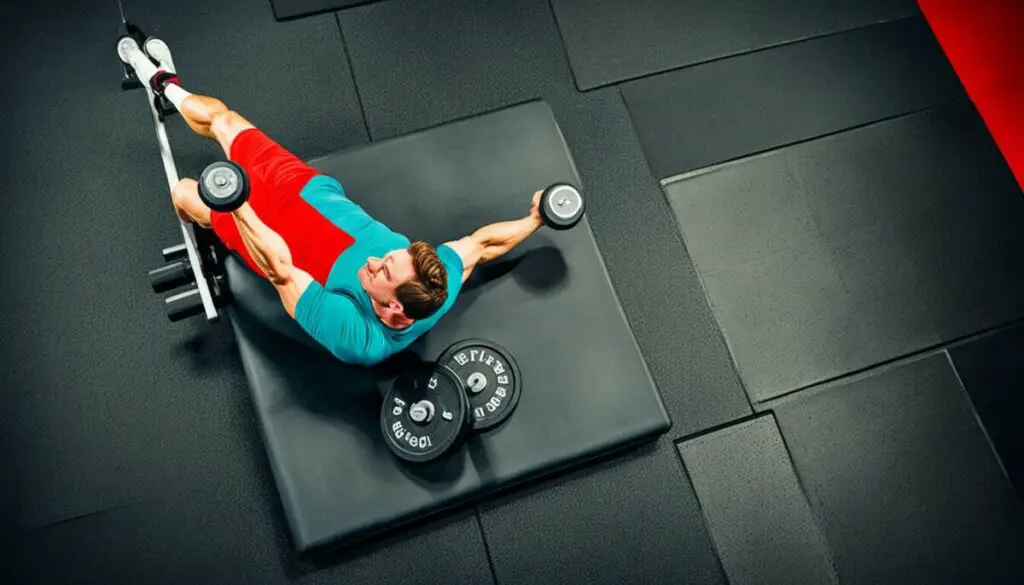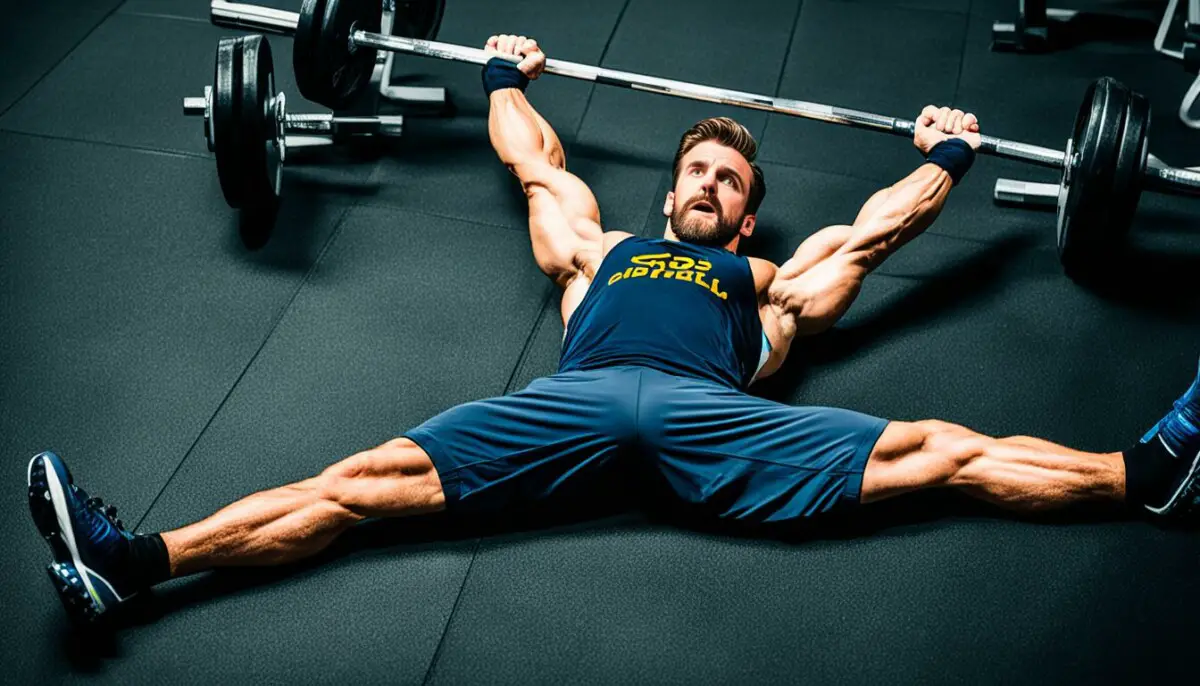Last Updated on 3 months by Francis
The floor press is a versatile exercise that can take your upper body strength to new heights. Whether you’re a seasoned lifter or just starting out, the floor press can help you build a solid foundation and target key muscle groups.
The barbell floor press, also known as the floor press with barbell, is a variation of the bench press that is performed lying on the floor. This exercise primarily targets the chest, triceps, and upper back muscles while minimizing strain on the shoulders.
One of the main benefits of the barbell floor press is its ability to improve lockout strength. By starting the press from a dead stop on the floor, you’ll develop the ability to power through the most challenging part of the bench press movement.
Not only is the floor press effective for improving lockout strength, but it also helps to increase pressing strength overall. By focusing on the upper portion of the pressing movement, you’ll build strength in the triceps, pecs, and shoulders.
Beginners can benefit from the floor press by using it as a primary lift, while experienced lifters can incorporate it as an accessory movement to target specific muscle groups. It’s a versatile exercise that can be tailored to individual goals and fitness levels.
Contents
Key Takeaways:
- The floor press is a variation of the bench press performed lying on the floor.
- It primarily targets the chest, triceps, and upper back muscles.
- The floor press helps improve lockout strength and increase pressing strength.
- It is suitable for both beginners and experienced lifters.
- By incorporating the floor press into your training routine, you can enhance your upper body strength and take your lifting to the next level.
How to Do the Floor Press

To perform the floor press, follow these steps:
- Position yourself on the floor underneath the barbell.
- Place your feet, hips, and upper back on the floor.
- Grip the barbell firmly with an overhand grip, slightly wider than shoulder-width apart.
- Pull your elbows down towards your torso, engaging your lats.
- Lower the weight until your elbows touch the floor, keeping your upper arms in contact with the ground.
- Drive the weight back up by extending your elbows, pushing through your triceps.
- Lower your elbows back to the floor to complete one rep.
Remember to maintain proper form throughout the movement. Keep your core engaged, and don’t let your lower back lift off the floor. Focus on controlling the weight and exhaling as you press it back up.
The floor press is a great exercise for targeting the triceps and improving lockout strength in the bench press. It can be performed with a barbell, dumbbells, or other variations using accommodating resistance like chains or resistance bands.
To visualize the proper form, refer to the image below:
Benefits of the Floor Press

The floor press offers numerous advantages that make it a valuable addition to any strength training program. Let’s take a closer look at some of the key benefits:
Increased Triceps Muscle Activation
The floor press places a greater emphasis on the triceps compared to traditional bench pressing. By limiting the range of motion, it allows for more targeted triceps activation, helping to strengthen and develop these muscles.
Improved Upper Body Strength
The floor press is an effective exercise for building upper body strength, particularly in the chest, shoulders, and triceps. The pushing motion engages multiple muscle groups, leading to overall upper body strength gains.
Shoulder-Friendly Exercise
Unlike the bench press, the floor press can be more shoulder-friendly. By limiting the range of motion, it reduces stress on the shoulders, making it a safer option for individuals with shoulder issues or those looking to prevent shoulder injuries.
“The floor press is a fantastic exercise for building pressing strength while minimizing stress on the shoulders.” – Fitness expert, Sarah Davis
Targeted Bench Press Training
The floor press helps target specific aspects of the bench press, such as lockout strength and triceps engagement. By strengthening these areas, it can significantly enhance bench press performance and assist in breaking through training plateaus.
Muscle Hypertrophy
The floor press can also be used as an effective hypertrophy exercise. By performing the movement with higher repetitions and focusing on muscle time under tension, it can stimulate muscle growth and help individuals achieve their desired physique.
Overall, the floor press offers a range of benefits, from increased triceps activation and upper body strength to its shoulder-friendly nature and potential for targeted bench press training. Whether you’re an athlete, recovering from an injury, or simply looking to add variety to your workouts, the floor press is a valuable exercise to incorporate into your training routine.
| Benefits of the Floor Press |
|---|
| Increased triceps muscle activation |
| Improved upper body strength |
| Shoulder-friendly exercise |
| Targeted bench press training |
| Muscle hypertrophy |
Muscles Worked by the Floor Press

The floor press is an effective exercise that targets multiple muscle groups in the upper body. While the range of motion is limited compared to the bench press, it still activates key muscles needed for pressing movements.
The primary muscles worked by the floor press include:
- The pectoral muscles (chest): The floor press engages the chest muscles, specifically the pectoralis major and pectoralis minor.
- The triceps: The triceps are heavily involved in the floor press movement, as they are responsible for extending the elbows and assisting in lockout.
- The rhomboids and scapular stabilizers: These muscles in the upper back help stabilize the scapulae and provide support during the pressing motion.
Although the floor press limits the range of motion compared to the bench press, it still effectively engages these muscles, making it a valuable exercise for building upper body strength and targeting key muscle groups.
Who Should Do the Floor Press

The floor press is a versatile exercise that offers benefits for a wide range of individuals. Whether you’re a strength athlete, recovering from an injury, or simply looking to enhance your upper body strength and add variety to your pressing routine, the floor press can be an excellent addition to your training program.
Here are the key groups of people who can benefit from incorporating the floor press into their workouts:
Strength and Power Athletes
The floor press is particularly beneficial for strength and power athletes. By focusing on the lockout portion of the bench press, the exercise helps to improve triceps strength and lockout power, ultimately translating to a stronger bench press. Additionally, the floor press challenges stability and engages stabilizing muscles to a greater degree, contributing to overall strength gains.
Injury Rehabilitation
Individuals rehabbing from shoulder or pectoral injuries can benefit from the floor press due to its more shoulder-friendly nature. By limiting the range of motion and reducing strain on the shoulders, the exercise allows for targeted strengthening of the chest and triceps without exacerbating existing injuries. Consult with a healthcare professional or a qualified trainer to determine if the floor press is suitable for your specific injury and rehabilitation needs.
Overall Upper Body Strength Development
For those seeking to improve their overall upper body strength, the floor press provides an effective way to target the chest, triceps, and supporting muscles such as the rhomboids and scapular stabilizers. As a compound movement, the floor press engages multiple muscle groups, promoting balanced strength development and aiding in muscle hypertrophy.
By incorporating the floor press into your training routine, you can enhance your strength, power, and muscle development while mitigating the risk of shoulder and pectoral injuries. Whether you’re an athlete, recovering from an injury, or simply looking for a new challenge, the floor press is a versatile exercise that can help you achieve your fitness goals.
Next, we’ll explore the recommended sets, reps, and programming for the floor press to optimize your training.
Floor Press Sets, Reps, and Programming Recommendations

When it comes to floor press training, the sets, reps, and programming recommendations can vary depending on individual goals. Whether you’re looking to gain muscle mass or increase strength, there are specific guidelines to follow to optimize your workout.
Gaining Muscle Mass: If your main objective is to build muscle, incorporating moderate to heavy loads with higher rep ranges can be effective. Here are some recommended set and rep schemes:
| Rep Range | Sets |
|---|---|
| 5-10 reps | 3-5 sets |
| 10-20 reps | 3-5 sets |
| 20-30 reps | 3-5 sets |
Gaining Strength: If your focus is on increasing strength, it’s important to work with heavier loads for fewer repetitions. Here is a recommended set and rep scheme for strength training:
| Rep Range | Sets |
|---|---|
| 3-5 reps | 3-8 sets |
Remember, these recommendations serve as general guidelines. It’s essential to listen to your body, adjust the intensity as needed, and gradually progress over time. Consistency and proper form are key to achieving your desired results with the floor press.
By following the appropriate sets, reps, and programming strategies, you’ll be able to effectively incorporate the floor press into your strength training routine. Whether your goal is to build muscle mass or increase strength, the floor press offers a versatile and challenging exercise that can help you achieve your desired outcomes.
Floor Press Variations
Looking to add variety to your training program? Incorporating different variations of the floor press can help target specific muscle groups, challenge your muscles in new ways, and keep your workouts engaging. Here are three popular floor press variations to consider:
Dumbbell Floor Press
The dumbbell floor press is a great variation that offers unilateral training benefits and helps improve overall pressing strength. To perform the dumbbell floor press, lie on your back with a dumbbell in each hand. Keep your elbows close to your sides as you lower the dumbbells until your upper arms touch the floor. Pause briefly, then push the dumbbells back up to the starting position.
Floor Press with Chains or Resistance Bands
Adding chains or resistance bands to the floor press can provide accommodating resistance, helping to build explosive power and improve lockout strength. By gradually increasing the load as you extend your arms, these variations make the lift more challenging at the top, where you’re typically the strongest. Set up the chains or resistance bands by attaching them to the barbell and performing the floor press as usual.
Concentric Floor Press
The concentric floor press emphasizes the concentric (lifting) phase of the movement, helping to develop explosiveness and power. To perform the concentric floor press, start with the barbell on the floor. Get into position underneath the barbell, tighten your core, and drive the weight up explosively until your arms are fully extended. Lower the barbell back down to the floor and repeat for the desired number of reps.
These variations can be incorporated into your training program to add variety, challenge your muscles, and enhance your overall pressing strength. Experiment with different combinations and find the ones that work best for you.
Floor Press Alternatives
If the floor press is not suitable or available, there are alternative exercises that can target the chest and triceps. These alternatives can help address individual weaknesses, improve shoulder stability, and increase strength and muscle hypertrophy.
Board Press
The board press is a popular alternative to the floor press that allows you to work through a partial range of motion. By placing wooden or foam boards on your chest, you limit the depth of the press, allowing you to focus on the lockout portion of the movement. This exercise can be beneficial for those who struggle with the initial portion of the bench press or want to overload the triceps.
Spoto Press
The Spoto press is another great alternative that targets the chest and triceps while improving stability and control. To perform the Spoto press, you lower the barbell to a point just above your chest without touching it. This eliminates the stretch reflex and requires you to maintain tension throughout the movement. By pausing at this point, you effectively work on strength, stability, and overall pressing control.
Both the board press and the Spoto press can be incorporated into your training routine as variations of the floor press. They provide options for targeting specific muscle groups, addressing sticking points, and adding variety to your workouts.
Remember to choose exercises that align with your goals, abilities, and equipment availability. By incorporating these floor press alternatives, you can continue to challenge your upper body strength and maximize your training potential.
Conclusion
The floor press is a highly beneficial exercise that offers a range of advantages for individuals looking to improve their upper body strength and overall pressing performance. By incorporating the floor press into your training routine, you can target the triceps, build muscle, and enhance your lockout in the bench press.
Whether you are a strength athlete aiming to increase your pressing power, rehabbing from an injury and in need of a shoulder-friendly exercise, or simply looking to add variety to your pressing program, the floor press is a valuable tool.
To perform the floor press, position yourself on the floor with the barbell, ensuring your feet, hips, and upper back are firmly planted. Lower the weight until your elbows touch the floor, then explosively drive the weight back up until your elbows are fully extended. Remember to maintain proper form and engage your triceps throughout the movement for optimal results.
Incorporate the floor press into your training regimen and experience the benefits it provides for increasing strength, targeting the triceps, and improving your bench press lockout. It’s time to take your upper body strength to new heights with the floor press!
FAQ
What is a floor press?
The floor press is a highly effective pressing variation performed with a barbell. It involves lying on the floor and pressing the weight from a dead stop position. It helps improve lockout, increase pressing strength, and target the triceps.
How do I perform the floor press with a barbell?
To perform the floor press, start by lying on the floor underneath the barbell. Place your feet, hips, and upper back on the floor. Grip the barbell firmly and pull the elbows down towards the torso. Lower the weight until your elbows touch the floor, then drive the weight until your elbows are fully extended. Lower the elbows back to the floor to complete one rep.
What are the benefits of the floor press?
The floor press has several benefits, including increased triceps muscle activation, improved upper body strength, and it can be more shoulder-friendly than traditional bench pressing. It can also be used to target specific aspects of the bench press and assist in muscle hypertrophy.
Which muscles are worked by the floor press?
The floor press primarily works the pectoral muscles (chest), triceps, and the rhomboids and scapular stabilizers for upper back support. While the range of motion is limited compared to the bench press, these muscles are still activated during the movement.
Who should do the floor press?
The floor press is beneficial for both beginners and experienced lifters. It can be used by strength and power athletes as well as individuals rehabbing from shoulder or pec injuries. It is also suitable for those looking to improve overall upper body strength and incorporate variety into their pressing programs.
What are the recommended sets, reps, and programming for the floor press?
The sets, reps, and programming for the floor press can vary depending on individual goals. To gain muscle mass, training volume at moderate to heavy loads with rep ranges of five to 10, 10 to 20, or 20 to 30 reps for three to five sets can be effective. To gain strength, focus on heavier loads for fewer reps, such as three to five reps for three to eight sets.
Are there variations of the floor press?
Yes, there are several variations of the floor press that can be incorporated into training programs, including the dumbbell floor press, floor press with chains or resistance bands, and the concentric floor press. These variations provide options for targeting specific muscle groups and adding variety to workouts.
What are some alternatives to the floor press?
If the floor press is not suitable or available, there are alternative exercises that can target the chest and triceps, such as the board press and Spoto press. These exercises can help address individual weaknesses, improve shoulder stability, and increase strength and muscle hypertrophy.
In summary, why should I consider incorporating the floor press into my training routine?
The floor press is a versatile and effective exercise for building upper body strength, targeting the triceps, and improving lockout in the bench press. Whether you are a strength athlete, recovering from an injury, or looking to vary your pressing program, the floor press can be a valuable addition to your training routine.









